Besides the pretty pictures aspect (and I enjoy the pretty pictures, both taking them and seeing them online), photography has multiple uses that support wildlife and land management. For instance…I’m almost at the pond and a weakly-flying near-dragonfly-sized insect flies up and lands on the underside of a small limb. I can’t, with my eyesight, see it clearly. I know it’s not a dragonfly, butterfly, or moth, but what is it? If I get too close it will fly away.
Enter the camera with a zoom lens:
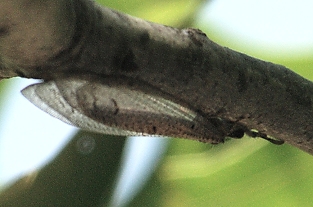 Though I can’t see it clearly in real life, once the images are in the computer I can enlarge them, lighten them if necessary, and suddenly–I remember photographing the same insect last summer, when it was on a window screen. It’s an adult ant-lion, and last summer, with the help of experts, I was able to give it a name, Euptilon ornatum. The presence of adult ant lions and immatures (found but not photographed) indicates successful reproduction here, which means we’re providing at least minimal habitat for them.
Though I can’t see it clearly in real life, once the images are in the computer I can enlarge them, lighten them if necessary, and suddenly–I remember photographing the same insect last summer, when it was on a window screen. It’s an adult ant-lion, and last summer, with the help of experts, I was able to give it a name, Euptilon ornatum. The presence of adult ant lions and immatures (found but not photographed) indicates successful reproduction here, which means we’re providing at least minimal habitat for them.
Similarly, I’ve documented dragonfly reproduction by photographing male and female of the same species, including ovipositing by the female. Here’s a pair of Neon Skimmers, Libellula croceipennis; the female is coming down to “splash” her eggs onto an algal mat.
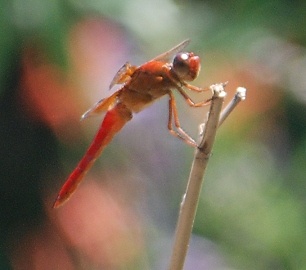
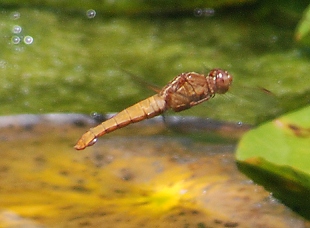
She uses the wide, rather spatulate final segments of her abdomen to scoop-and-splash as she releases an egg (you can see one, that white bit.)
In the past, I’ve also photographed odonate larvae in the pond, and the exuviae (the larval exoskeleton left behind when the adult emerges) but don’t have any current ones to show. Having photographs of the complete life cycle documents successful reproduction but may be hard to find for all species. I’ve also used photography to document possible disease (on a bird) and external parasites (mites on a dragonfly.) Sometimes I don’t even see the interesting details through the lens, but something shows up in the computer that I can research and make note of. The smaller and harder to see the “bug” or other wildlife (or plant), the more useful photography can be.
Photographs of wildlife using the pond to drink prove that it’s serving wildlife, not just stray cats. We were clearing the iris overload out this week, which opened more surface for bees and wasps to drink:
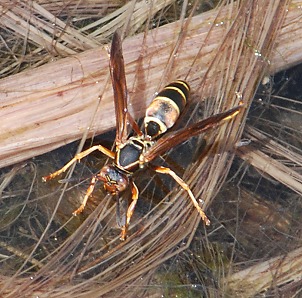
This colorful wasp is using the half-rotted leaves and inner leaf fibers of iris as support while drinking. R- found a scorpion as well as other insects in the iris root mat as he cut off the tops, but did not get a picture.
Back to the pretty pictures aspect.
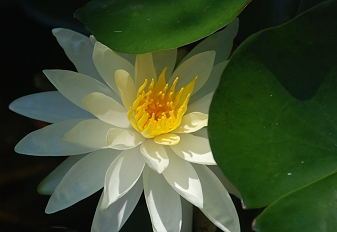
Comment by Abigail M — June 13, 2009 @ 6:08 pm
I wonder if I have ever seen an adult ant-lion? I suppose I probably have, but never to recognize, or even to wonder, “What bug is that?”
I’ve known the conical sandy ant-traps for ever, and as a child used to tease the larvae by knocking a tiny avalance down one side, to see the “lion” try to capture it. Hmm — adult ant-lions. I’ll have to keep my eyes peeled.
Abigail
Comment by elizabeth — June 13, 2009 @ 7:10 pm
I think I’ve seen one three, maybe four times, in the past 10 years. They’re mostly out in the dusk or night, and they spend the days perched somewhere. You’ll see them if you disturb their resting place–they fly weakly, a vague sort of flutter, and their wings (at least in many species) are gauzy-looking. They’re in Neuroptera, which pretty much guarantees odd-looking eyes and a mismatched part-this, part-that appearance overall.
So if you walk by a tree or bush and something vaguely flutters off, barely visible, follow it with your eyes and then sneak up on it.
Here’s a picture of a different species than mine: http://bugguide.net/node/view/62389
And here’s a link to the one I photographed last year:
http://bugguide.net/node/view/186599